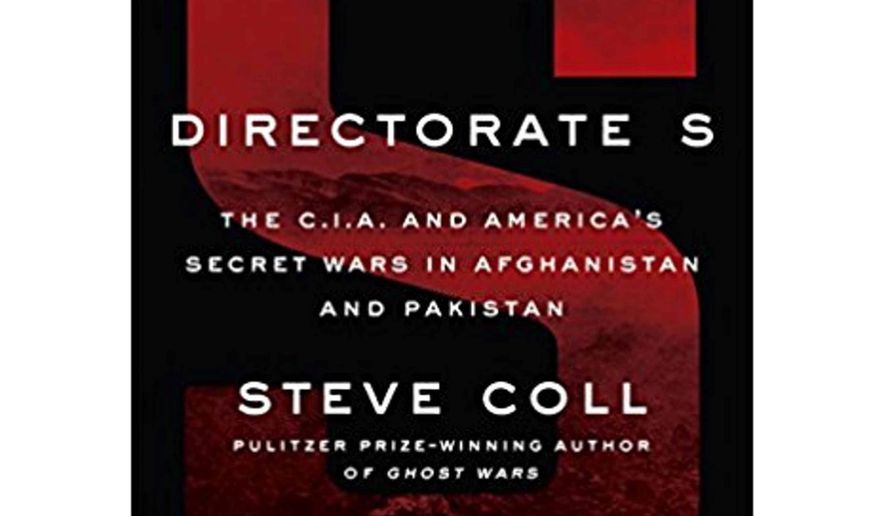OPINION:
DIRECTORATE S: THE C.I.A. AND AMERICA’S SECRET WARS IN AFGHANISTAN AND PAKISTAN
By Steve Coll
Penguin Press, $35, 784 pages,
With the appointments of John Bolton as the National Security Adviser and Mike Pompeo as the secretary of State, the Trump administration is likely to embark on a major review of the policies and programs guiding the 16-year U.S. political and military involvement in Afghanistan.
They will also examine the extent to which the Pakistani government is cooperating with the U.S. in countering these insurgents, or whether it is playing a double game by shielding the Pakistani Taliban, as well as providing a safe haven to the remnants of al Qaeda, especially to Ayman al Zawahiri, Osama bin Laden’s successor, somewhere in Pakistan.
How these strategic and military challenges will likely play out and the historical background that has shaped them since the beginning of the American intervention in Afghanistan in October 2001, are central to Steve Coll’s important book, “Directorate S: The C.I.A. and America’s Secret Wars in Afghanistan and Pakistan.”
This book is the second volume and update of the author’s best-selling “Ghost Wars: The Secret History of the CIA, Afghanistan, and Bin Laden, from the Soviet Invasion to September 10, 2001,” published in 2004.
This book, according to Mr. Coll, seeks to provide a “history of how the C.I.A., I.S.I. [the Pakistani intelligence service], and the Afghan intelligence agencies influenced the rise of a new war in Afghanistan after the fall of the Taliban [in late 2001], and how that war fostered a revival of al Qaeda, allied terrorist networks, and, eventually branches of the Islamic State. The book also seeks to connect American, Afghan, Pakistani, and international policy failures to the worldwide persistence of jihadi terrorism.”
What is remarkable about this book is Mr. Coll’s recounting of numerous behind-the-scenes meetings and memos by high level Bush and Obama administration officials and their Pakistani and Afghanistan government counterparts, as each side attempted to press its case to manage and, if possible, resolve, the difficult and problematic political and military situation in Afghanistan.
The American initiatives can be outlined as a series of themes. In one theme, as developed by Mr. Coll, numerous American policy initiatives toward Afghanistan by the Bush and Obama administrations were well-intentioned but lacked follow-through.
In 2003, Mr. Coll writes, in the words of a National Security Council (NSC) official, “the new White House plan for Afghanistan was better understood as a plan to write plans: ’What’s our plan to reform the judiciary? What’s our plan to deal with people who had been captured on the field of battle, our reconciliation plan?’ How would they build up the Army and reform the Ministry of Defense and professional the Afghan spy service under Engineer Arif?” The NSC official then added that the problem was that “They were all ’not done.’”
These issues were still unresolved in late 2010, when an Obama administration review listed American “lines of effort” in Afghanistan as degrading the Taliban militarily and building Afghan capacity to fight the war, placing Afghan forces in the lead combat role, stabilizing Afghanistan through regional diplomacy, and pursuing “political reconciliation with the Taliban, through direct talks.”
A second theme concerns the possibility of reconciliation with the Taliban. Mr. Coll discusses the efforts by the Obama administration to resolve the Taliban insurgency by unilaterally entering into back-door dealings with what it regarded as “moderate” elements within the Taliban’s leadership, in the form of Tayeb Agha, head of the Taliban political commission.
The effort, led by former Secretary of State Hilary Clinton, naively expected that “an Afghan-led political process [would] split the weakened Taliban off from al Qaeda and reconcile those who will renounce violence and accept the Afghan constitution.”
By 2014, this peace initiative ended in failure as the Taliban proved to be deceitful, with Mr. Coll observing that “the causes of the failure seemed to lie ’closer to home.’ How could the most powerful government on Earth, with tens of thousands of troops at war, mess up so badly?” A participant in the initiative observed, “It was so much the amateur hour, Keystone Kops It was just terrible. Terrible. This is the United States. This is what we do?” One of the strategic mistakes by the Bush and Obama administrations was their inability to “resolve essential questions about the conflict.”
Today, with the Taliban and the Islamic State together controlling a varying estimate of 10 to 33 percent of the Afghan territory, it appears everyone is lowering the metric of effectiveness for the U.S. involvement in Afghanistan, as Mr. Coll writes, from eliminating the Taliban’s guerrillas and leadership to merely achieving “an acceptable state of equilibrium and slow progress that would keep the country free from reign by the Taliban or the Islamic State and prevent any rekindling of al Qaeda or its ilk on Afghanistan territory. Eventually, the war might yield peace negotiations, as in Colombia.”
With the Taliban intensifying its brutal insurgency in Afghanistan and continuing government weakness, however, even such lowered expectations of effectiveness are not likely to be achieved.
“Directorate S” is an indispensable guide for understanding the significant issues that need to be addressed in formulating new political and military strategies to guide the next phase in America’s involvement in Afghanistan.
• Joshua Sinai is a senior analyst at Kiernan Group Holdings (KGH), in Alexandria, Va.




Please read our comment policy before commenting.